These Tender Ashes
June 9th, 2014Fire touches everything, eventually. Eventually, it touches something dear. The hubris of infinite precaution finally fails, then reconciliation becomes mandatory. Despair probably happens, but that too is temporary. Latent procedures activate. Poise turns to strike. Cyclic dialectics tilt toward the young, the fecund, the meek, the haggard. After a short interval, little evidence of cataclysm remains except a few charred limbs.
Two years ago, I received news that one of my dearest places had burned in wildfire. That high desert oasis had hosted my initiation into backcountry living at age seventeen. I had taken my daughter there as soon as she could walk to anoint her into the wilds with those artesian waters. It is a mostly uncharted place, hidden if not remote, so information about the fire amounted to a few scratched lines on a map. I feared the worst.
I was never part of a family that owned a second home or some tract of scenic property. Like so many working-class Westerners, I always considered the wild commons my second home. It’s an expansive way of mind that also makes certain conceits impossible. The wilds don’t stay the way I left them. They are their own manager. To sustain and persist in wild homemaking requires submission to change, an acceptance of designs that one does not design or commission. I confess I never envied the propertied. Ownership beyond a primary dwelling seems a nuisance that acts as a drug on the consciousness. It sows delusions of control, mythologizes protection from the unpredictable. Wilderness has been my drug of choice, and wilderness is always changing, yet always familiar.
Fire scars are less obvious in the sage steppe than in the forest, and I had forgotten about the burn until I was halfway down the trail and ready to seek shade under a large juniper I remembered from the last trip. The tree was missing and a charred stump stood in its place. It was spring and the desert was at its most colorful. Wildflowers bloomed all around and the bunchgrass was green during these brief months. But many of the junipers had become snags and some of the sage remained only as black skeletons. The landscape seemed more alive than usual. Rings of flowers grew around the snags where they had previously been deprived of light and water. Insects and birds were abundant and diverse, and over some small berm would be a cluster of surviving junipers.
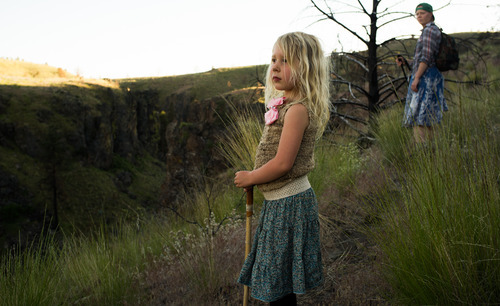
As I descended the canyon, I noticed that none of the stream-side plants had burned. The cluster of tiny springs that formed a microcosm of tributaries along the floodplain remained intact. Down here, most of the junipers were dead. The ponderosa pines were charred around the base but seemed unperturbed by it. Some of the birches and willows had burnt up, but already had two meters of bushy new stems coming up as replacement. And on a steep slope formerly dominated by a thicket of juniper, a forest of mullein was rising. Because mullein is a biennial, its age is obvious and almost all of the plants were in their first or third year. Apparently the latent seed had all sprouted at once in the spring after the fire. The second year, they set seed, and now the next generation was beginning among the desiccated seed-heads of the first. The timing was written clear as a calendar.
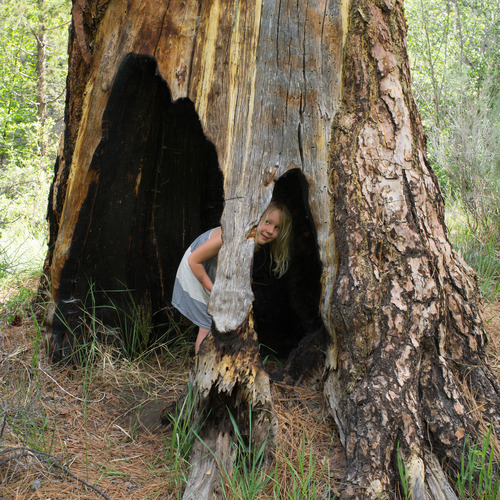
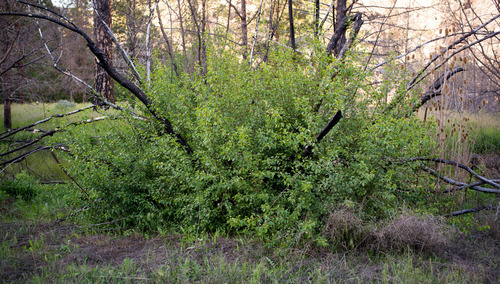
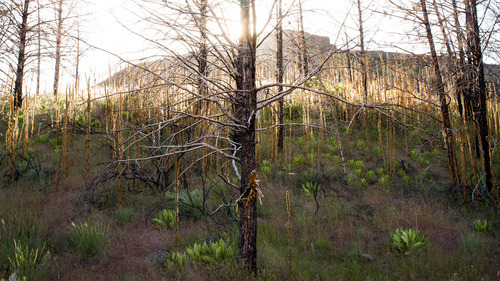
To a human, whose main threat is other humans, there is no place more tranquil than a desert spring. It is a crossroads where everyone comes to drink, and a fragile truce prevails. As I behold the intricate food web of this world-in-miniature, I reflect on how evolution has endowed us with complex sensory systems and information processing brains, with the happy result that we can read the emotions of other creatures with moderate accuracy. Up on the rimrock, alertness prevails, fatigue and hunkering down are ascendant. Near the spring, my companions are relaxed, the strangers I encounter are warm and friendly, even the rattlesnake seems in a gentle mood as she warns me not to step closer. I believe that all vertebrates, at minimum, posses this emotion reading capability, and can thus participate in a collective de-escalation of fear response. Plants probably make a subtler contribution. The fire has done nothing to diminish this experience. The landscape feels cleansed rather than war-torn.
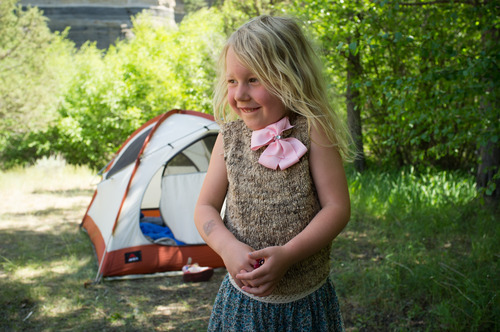
Every year, in the spring, my household enacts a purge of possessions in preparation for the summer’s scavenging. Needs shift, and we give objects away to friends and neighbors in an event that is both ritualistic and practical. Afterward, the house feels open, poised to receive. Dust, memories, and tightness all diminish. Ideas shift too. I grew up in a small room I shared with my brother. We had bunk beds and about a dozen Smokey the Bear posters evangelizing fire prevention, which I now understand as coded protection for the timber industry’s state-subsidized profits. My daughter shares her room with her pretend friend, Fire, who was born in a volcano and now happily cohabits with us. Fire is friend to all who would befriend her; who would tolerate her creative destruction; who would carve out a space in themselves for the untamed and untamable. The desert also feels friendly now after the fire. Here is no post-apocalypse but a jubilee and reboot. Fire may be inevitable, but cataclysm is not extinction. It is prelude.
